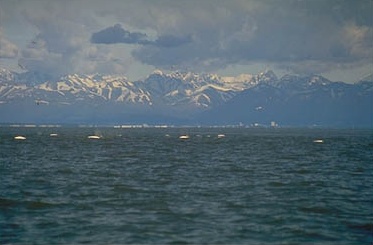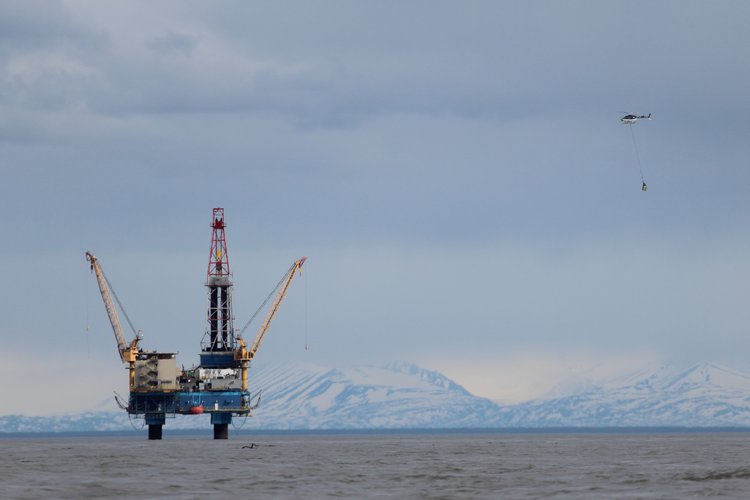
Mixing Oil with Water
Trustees for Alaska has a long history of protecting the clean water and wildlife resources of Cook Inlet from pollution and harmful developments. The Cook Inlet watershed covers nearly 47,000 square miles, extending from the Gulf of Alaska to Anchorage and as far north as Denali National Park and Preserve. Roughly two-thirds of Alaska’s population lives in Southcentral Alaska. Many Alaskans depend on it for subsistence use, commercial fishing, and recreational fishing. Cook Inlet is also home to five species of salmon and several threatened and endangered species, including beluga whales, Steller sea lions, Steller’s eiders, and northern sea otters.

The Osprey oil and gas platform—one of the only facilities that doesn’t discharge directly into Cook Inlet—sits near West Foreland across Cook Inlet from Nikiski. Photo courtesy of Ground Truth Trekking.
Cook Inlet is also considered the birthplace of Alaska’s oil and gas industry. The first commercial-scale oil discovery in Alaska was on the Kenai Peninsula at Swanson River in 1957. This discovery is recognized as one of the catalysts for Alaska statehood two years later. Since then, the Cook Inlet oil and gas industry has produced over 1.4 billion barrels of oil and 7.75 trillion cubic feet of natural gas. But oil and gas and clean water don’t always go hand-in-hand, and this development comes at a cost for Cook Inlet.
Trustees’ work to protect Cook Inlet from harmful oil and gas discharges extends back for decades. In 1995, Trustees negotiated a settlement with several oil and gas operators for over 4,200 violations of their Clean Water Act discharge permits. In the settlement, the operators agreed to end their unlawful discharges and paid $895,000 to establish Cook Inletkeeper—an independent, citizen-based watchdog organization that continues to advocate for Cook Inlet. The settlement was one of the largest in the history of the Clean Water Act.

The Cook Inlet population of beluga whales was listed as endangered in 2008, ten years after Trustees for Alaska petitioned for their protection. This population is one of five stocks of beluga whales found in Alaska, and the most genetically and geographically isolated. The State of Alaska attempted to have the species de-listed, but failed when the Federal District Court rejected their lawsuit against the National Marine Fisheries Service. Trustees intervened in the case on behalf of several conservation groups. NOAA photo
Despite the fact that Cook Inlet is home to most of Alaska’s people and is important for subsistence, commercial, and recreational users, it is the only waterbody in the United States where oil and gas facilities are allowed to discharge toxic drill cuttings and other wastes directly into coastal waters. Every other oil and gas facility in coastal waters around the country is required to meet a “zero discharge” standard. This loophole means facilities dump thousands of gallons of oil and tons of toxic discharges each year that have already been eliminated at other facilities.
Trustees for Alaska seeks to hold Cook Inlet facilities to the same standards as the rest of the nation. Trustees has pushed for changes to close the regulatory loopholesand uses legal tools to hold facilities and agencies accountable. Trustees will continue to work with a coalition of tribes and other organizations, including Cook Inletkeeper, to protect the clean water, fish, and wildlife resources.
Read other stories on our work to protect Cook Inlet.
Read stories on just our work to protect the Cook Inlet beluga whales.


